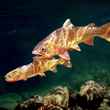This just in. Muskies are hard to catch. That is all.
OK, that’s a little simplistic, but the results of a new study show that muskellunge (Esox masquinongy) are, indeed, the “fish of 10,000 casts,” and that catch-and-keep practices involving muskies might be the worst thing anglers can do for the musky fishery and for other anglers.
The study, conducted by John F. Bieber, Michael J. Louison and Cory D. Suski of the University of Illinois, determined that bigger, more sedentary muskies that don’t move around much and don’t display overt aggression are actually the fish that are more likely to hit a lure (or, presumably, a streamer).
“Muskellunge displaying low levels of exploration and aggression were preferentially captured. Behaviors such as boldness and activity did not influence capture, and metabolic parameters did not differ between captured and uncaptured fish,” the study’s abstract reads.
Muskies are largely ambush predators, and the study, conducted in a pond stocked with 68 laboratory-raised muskies over the course of 35 days, found that once the larger fish were caught and removed, the catch rate for the other fish declined precipitously. And, in order to catch the larger fish, the science-minded anglers had to put lures right in the faces of the fish to entice a strike. Angling success for more active fish, or for fish that displayed more aggression, was decidedly less productive.
"After 35 days throwing our whole arsenal at them, every combination of time of day, lure, and casting style, we can verify muskies are indeed the fish of 10,000 casts,” Bieber told phys.org. We only caught seven fish. In addition, we saw that catch rates decline very, very rapidly after the first several days," Bieber said. "It was a long month."
The study’s authors wanted to get to the bottom of the musky mystery: why are these fish–sometimes true river monsters–so damned difficult to catch?
“We sought to define the mechanisms driving individual angling vulnerability in muskellunge, with the intent of informing management activities to conserve populations,” the study reads. “After angling, all captured fish and a subset of uncaptured fish were assessed for metabolic parameters.”
The results of that assessment? Metabolism apparently has nothing to do with why some muskies hit flies and lures and why others just don’t. But the potential ramifications that come from removing the bigger, sneakier fish – those more likely to attack a fly or lure – from the population could be bad for the musky fishery.
“Over time, the removal of vulnerable individuals can erode capture rates, possibly resulting in evolutionary changes if traits that result in capture correlate with characteristics such as fecundity or growth,” the study reveals.
Another disheartening finding in the study: simply fishing for and catching muskies, with no intention of harvesting fish, might be detrimental to the fishery, too. That’s not likely going to stop anglers from pursuing these fish, but, at the very least, the study allows them to go into the proposition with their eyes wide open.
“Many fisheries are subject to harvest by recreational anglers, with captured fish being consumed for food. In addition, even for situations in which an angler's goal is not to harvest fish for food, angled fish are subjected to a host of challenges, including hooking, exercise, and air exposure,” the study reads. “In some cases, fish may experience initial or delayed mortality after angling due to the cumulative impacts of these stressors. The loss of individual fish from the population can accumulate and lead to decreases in population size, which may occur even when capture rates remain high.”
The message? If you’re going to fish for muskies–and let’s face it, the fish has an enthusiastic, if gritty, cult following, particularly among the fly-fishing crowd–learn and practice the best fish handling techniques and make sure the battle with the big fish is as short and tight as possible.
Muskies are long-lived apex predators in any ecosystem in which they are found, native or otherwise. According to the study, some muskies live to be 30 years old or older. Because of their fierce, predatory nature, they are the most influential fish in just about any body of water they inhabit. The prospect of losing the fish most likely to eat on a regular basis could be troublesome for some bodies of water, particularly in places where the fish is native.
The study’s most interesting finding likely isn’t that some fish are more likely to hit flies or lures than others, but that, in muskies, it’s the fish that don’t do much other that lie in wait to eat. In other fish species, the study notes, it’s often the more exploratory or “extroverted” fish that fall prey to anglers.
“Animal behaviors can be categorized into five separate axes: aggression, boldness, activity, exploration, and sociability,” the study reads. In other similar studies, other species of fish that were most vulnerable to capture were fish with more active traits. “In common carp, bolder and more active individuals were captured. In rainbow trout, individuals that were more active and stress-resilient were disproportionately captured. Work with largemouth bass found that individuals with a lower stress responsiveness and higher aggression during the brood-guarding stage were captured. In addition, (a separate study) showed that populations of largemouth bass that were highly vulnerable to angling had increased metabolic rates relative to less-vulnerable conspecifics, thereby indicating a link between angling vulnerability and metabolic parameters. Behavior in fish is a heritable trait that is consistent over time.”
But, it appears, at least with the prized musky, metabolism isn’t a significant factor in why a fish chooses to eat, or even when a fish chooses to eat.
The findings don’t faze well-known musky angler and guide Blane Chocklett, who fishes out of Roanoake, Va., on rivers like the James and the New. Living in the southern reaches of the musky’s introduced range (the fish are not believed to be native to Virginia), Chocklett spends his winters targeting the big predators. His observations are remarkably similar to those Bieber, Louison and Suski reported in their study.
“What I can say is that I generally target fish that are laying in their homes,” he said. I fish for them when they’re hanging out where they live.”
Over time, in his home rivers, Chocklett has come to identify ideal holding water for the big, sedentary fish that tend to stay in one spot or at least stay close to it.
“I think that’s just where they’re comfortable,” he said. “And often it won’t be just one fish in the same spot. Think about it like you would think about a pride of lions. They just lie around where they’re comfortable, and it may not have anything to do with structure. It could be about temperature, the type of bottom, the current. It’s just about comfort for the fish.”
In Chocklett’s mind, the study makes a lot of sense.
“I’ve spent years doing this. I’ve watched them in our clear water here,” he said. “I’m convinced that these fish are laying around dormant most of the time. Like, they sleep about 75 percent of the time. But, if you fish those spots often enough, and your fly gets close enough to kind of wake them up, you’ll get a strike.”
There are times when the fish will move around, Chocklett said, and that makes his job as a guide a little harder. In the South, Muskies spawn in March and April. Further north, in their native range in the Great Lakes states, muskies spawn May and June. When the spawn is on, the fish are more active, and Chocklett tends to leave them alone.
“Coming off the spawn in May can be a great time to target these fish, but they’re not where they usually are, so you have to go looking for them,” he said. “They can be everywhere or nowhere. But then, if we get a cold snap, those fish are back in their homes where they belong, and sometimes, there can be seven or eight fish in those places.
“Chances are, one of them will hit a fly.”
After about 10,000 casts, that is.































Comments
Larry Rand replied on Permalink
Pardon me for this niggling comment, but it should be "findings don't faze well-known muskie angler," not "phase" (I managed to enjoy the article nevertheless).
Pages